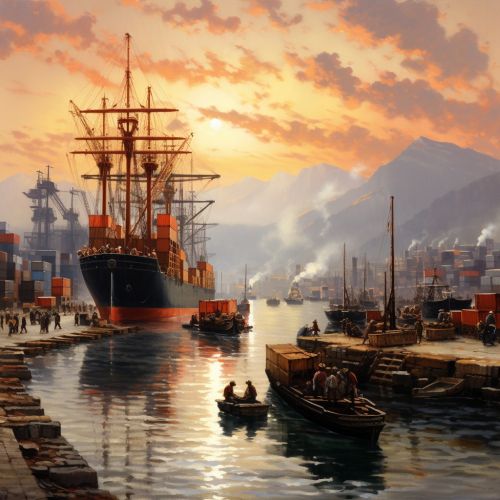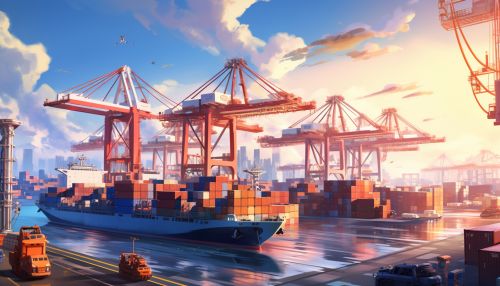International Trade
Overview
International trade is the exchange of goods and services across international borders or territories. It involves the import and export of goods and services between countries, which could be raw materials, manufactured goods, or services like tourism and banking. This trade forms a significant part of the gross domestic product (GDP) of many countries, and its influence on the global economy is profound.


History of International Trade
The history of international trade chronicles the economic, social and political influence of exchange of goods and services between nations. From the ancient trade routes like the Silk Road to the establishment of modern trade agreements, international trade has been a driving force in shaping civilization.
Ancient Trade Routes
Trade between nations is not a modern concept. Ancient civilizations like the Egyptians, Phoenicians, Greeks, and Romans engaged in international trade. The Silk Road and the Amber Road were two of the most significant trade routes in the ancient world, facilitating the exchange of goods, ideas, and culture between the East and West.
Age of Discovery
The Age of Discovery, from the 15th to 17th centuries, marked a significant expansion in international trade. European explorers like Christopher Columbus and Vasco da Gama discovered new trade routes, leading to an increase in trade between Europe, Africa, Asia, and the Americas.
Industrial Revolution
The Industrial Revolution in the 18th and 19th centuries further boosted international trade. Innovations in transportation, such as the steam engine and the Suez Canal, reduced the cost and increased the speed of trade.
Modern Era
In the 20th century, two World Wars and the Great Depression significantly affected international trade. However, post-World War II, the establishment of international institutions like the World Trade Organization (WTO) and trade agreements like the North American Free Trade Agreement (NAFTA) have facilitated and regulated trade between nations.
Theories of International Trade
Several theories have been proposed to explain the reasons for and benefits of international trade. These theories form the basis of international trade policy and guide the economic strategies of countries.
Mercantilism
Mercantilism is one of the earliest theories of international trade. It suggests that a nation's wealth is determined by its holdings of gold and silver. Therefore, nations should export more than they import, leading to a favorable balance of trade.
Absolute Advantage
The theory of Absolute Advantage, proposed by Adam Smith, argues that countries should produce and export goods that they can produce more efficiently than other countries.
Comparative Advantage
The theory of Comparative Advantage, developed by David Ricardo, suggests that countries should specialize in producing and exporting goods in which they have a lower opportunity cost.
Heckscher-Ohlin Theory
The Heckscher-Ohlin Theory posits that countries export goods that use their abundant and cheap factors of production and import goods that use their scarce resources.
International Trade Today
Today, international trade is a complex system governed by trade agreements and international institutions. It plays a crucial role in the global economy and has significant implications for economic development, political relationships, and global cooperation.
Trade Agreements
Trade agreements are treaties between two or more nations agreeing on terms of trade between them. They determine tariff rates, trade quotas, and other trade-related policies. Examples include the North American Free Trade Agreement (NAFTA) and the European Union (EU).
International Institutions
International institutions like the World Trade Organization (WTO), International Monetary Fund (IMF), and World Bank play a crucial role in regulating international trade. They set rules for trade, provide financial assistance to developing countries, and resolve trade disputes.
Globalization and Trade
Globalization has significantly impacted international trade, leading to increased interdependence among nations. It has resulted in the expansion of multinational corporations, increased foreign direct investment, and greater economic integration.
Impact of International Trade
International trade has both positive and negative impacts on nations, economies, and people. It can lead to economic growth, improved living standards, and cultural exchange. However, it can also lead to job displacement, economic disparity, and cultural homogenization.
Economic Impact
International trade can boost economic growth by providing markets for domestic goods, increasing efficiency through competition, and promoting innovation. However, it can also lead to job displacement in industries that cannot compete internationally.
Social Impact
International trade can improve living standards by lowering prices and increasing the variety of goods and services. However, it can also lead to economic disparity and cultural homogenization.
Environmental Impact
International trade can lead to environmental degradation through increased resource extraction, pollution, and greenhouse gas emissions. However, it can also promote the diffusion of environmentally friendly technologies and practices.
